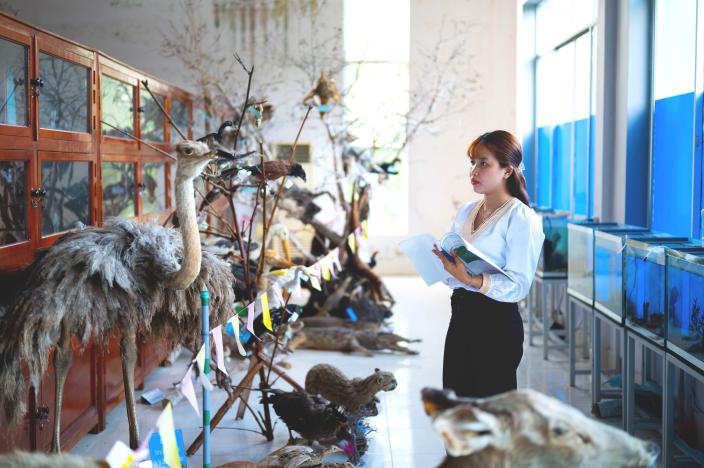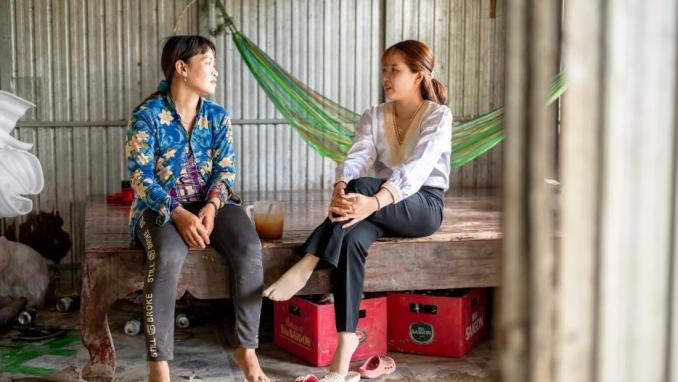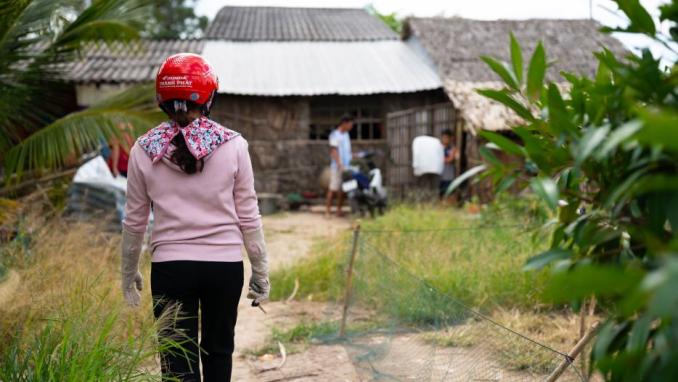“Who wouldn’t want their living environment to be fresh and healthy? Coping with it is even harder as a woman, since I must also take care of my children and make ends meet. But seeing people suffering like that, I can’t bear the sight.”
It was a sweltering spring afternoon when I first conversed with Ms. Linh. Having just finished a communication session on using and storing clean water, Ms. Linh struck me as nimble and spirited. “It is currently the dry season here at U Minh Thuong. Clean water is scarce, which is why my hands are full.”
Nguyen Ngoc Linh is one of the two female officers at U Minh Thuong Forest Management and Protection Department. With six years of experience under, she monitors biodiversity, forest resources, water, flora and fauna. A typical working day for Ms. Linh means patrolling and educating people on water resource protection and agricultural waste control.
“Water here in the buffer zone is already contaminated with alum and heavy metals. Making matters worse, people keep throwing household and agricultural waste onto the stagnant water,” Ms. Linh sighed. Since no clean water is available, people resorted to using drilled water, or worse, bucketing some straight out from the contaminated canals. People’s health is heavily compromised with immediate effects such as skin rashes, gynecological diseases, and longer-term consequences that leave children weak and immune systems undermined. That's not to mention the reduced aquatic animals, directly affecting people's livelihoods.
“Who wouldn’t want their living environment to be fresh and healthy? Coping with it is even harder as a woman, since I must also take care of my children and make ends meet. But seeing people suffering like that, I can’t bear the sight.” Linh summed up the motivation that made her “profoundly devoted” to reclaiming clean water to every household.
Linh assumed the responsibility to raise awareness and educate households in the buffer zone, especially those who still use water directly from the canals. She teaches people how to filter, boil, and store water for use.
To improve farmers’ livelihoods, Ms. Linh organizes and directly lectures in training workshops on short-term tree planting applying new techniques, and selection of suitable fruit trees. For women who want a secondary livelihood, Linh advises on products that best suit their specialty such as pressed bananas, dried taro, or knitted bags from banana trunks.
“Is it strenuous? A lot, compared to men. Is it worth it? Absolutely!” Linh laughed when asked about the job’s downsides, her eyes alight with determination. “Dealing with landslides is one, moving between houses in this large buffer zone is another.” Sometimes it takes several attempts to finally meet one household, since farmers are often at work all day. However, that does not dampen the young woman’s spirit. Linh saves their phone numbers, divides households into small clusters of 15 - 20, and schedules routine activities and discussions.
For Linh, geographical distance is but a minor barrier. What bothers her is the mixed opinions of people that received her consultations. “They would say the trash wasn’t theirs, but the next-door neighbor’s. They would discharge salt water into fresh water to raise shrimp. I more than once got the doors slammed in my face!” Recounting how she dealt with those difficult cases, Linh chuckled: "When they said it was the neighbors, I just knocked every door on that road and consulted them all!” Patience, perseverance, evidence-backed arguments, combined with official information from the news, that's how the unflappable woman gradually earned the trust of people in the U Minh Thuong buffer zone.
“They find what I’ve been saying valuable. Now they are more than welcoming, some even sent bananas as thank-you gifts.” After six years of campaigning, Ms. Linh now represents the people’s voice, especially women’s, to convey their opinions and wishes to the authorities and organizations. Most recently, she reflected to the Department’s leaderboard about the discharge of water from the UMT forest core into the buffer zone. The UMT region usually has 6 months of dry season and 6 months of wet season. During the wet season, the forest core zone will regulate water out into the buffer zone and the surrounding areas for Melaleuca trees to grow. Since people in the buffer zone have little access to the mass media, the discharge of water should be notified early to each house and hamlet, so that they are more proactive in livestock and farming.
On personal changes after years of social work, Ms. Linh confided: “Working with people didn’t use to be my specialty, so it was a difficult start. There were times when I was so discouraged I wanted to quit. But as I spoke more with the people and watched their struggle, I felt this irresistible urge to help them, especially the women, become more aware of water, air, and resources.”
“I myself have gained more knowledge on water governance in the buffer zone, thanks to the project. From now on, every time a household encounters a problem, we work together for solutions.” Ms. Linh also noticed a gradual transformation in the mindset of those she helped, especially the women. “They realized the need for change, and they wanted to create that change.” Farmers in the area are not only more receptive to the advice and consultations from this persistent woman, they are eager to spread what they’ve learned.
When inquired on future plans, Ms. Linh revealed her wish to acquire new knowledge so that she can directly provide vocational training for idle workers. “I’d love to learn from the project and open a small training course that can create stable jobs for women, then they won’t have to work as daily laborers.”
Casting a distant gaze towards the UMT forest, Linh hopes that the government will issue better policies to support the forest protection force, those that are, as Linh put it, sacrificing their lives to protect the forests, land, and water. For the people, increasing investment on the infrastructure would assure their stay in the buffer zone, replanting protective forests for the country, not destroying them for their livelihoods.
As we bid farewell, Ms. Linh hurried home to her 2-year-old daughter. Watching the petite figure mounting her weathered Honda motorcycle, I can’t help but feel that Linh, and other inspiring women like her, is the very embodiment of spring in this parched buffer zone.
Read more about the full 43 women leaders' stories at this LINK



